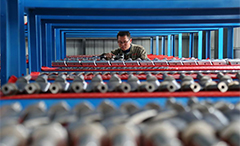China rolls out 5-year plan for intelligent manufacturing
2016-12-08
Xinhua
 Zhu Sendi, honorary director of experts committee under China Machinery Industry Federation, speaks at a forum of the World Intelligent Manufacturing Summit in Nanjing, capital of east China’s Jiangsu province, Dec 7, 2016. [Photo/Xinhua]
Zhu Sendi, honorary director of experts committee under China Machinery Industry Federation, speaks at a forum of the World Intelligent Manufacturing Summit in Nanjing, capital of east China’s Jiangsu province, Dec 7, 2016. [Photo/Xinhua]
China’s Ministry of Industry and Information Technology published the blueprint for 2016-2020 at the World Intelligent Manufacturing Summit that opened in Nanjing on Dec 7.
The plan is a long-term strategic task to develop intelligent manufacturing to generate new growth to improve the country’s manufacturing sector.
The blueprint calls for the speeding up of development in intelligent equipment and key common technologies, setting up of intelligent manufacturing standards, expanding intelligent manufacturing trials, and promoting intelligent transformation in key sectors and small and medium-sized companies.
Zhu Sendi, a counselor with the China Machinery Industry Federation, said China’s manufacturers are at different productivity levels, and many low-cost factories need to make efforts to catch up parts of the world with greater productivity.
You Zheng, vice president of Tsinghua University, said the country’s huge domestic demand offers bright prospects for China’s intelligent manufacturing.
The industrial upgrading of the manufacturing sector around the world also forces Chinese firms to upgrade, said Huang Xing, chairman of Sinomach Intelligence Technology.
The summit attracted policy makers and delegates from industry associations, research institutes and the Fortune 500 companies from many countries, including China, the United States, Germany and Switzerland.
In May 2015, China rolled out “Made in China 2025” initiative designed to transform itself from a low-cost manufacturing giant to a high-tech manufacturing power.
The national plan focuses on 10 priority sectors, including advanced rail, aviation and aerospace, agricultural machinery and technology, and new generation information technology.
The plan encourages domestic manufacturers to make technological breakthroughs in the emerging industries to shift towards more value-added production.



